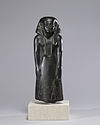
Summary
Padiiset's Statue or Pateese's Statue,[1] also described as the Statue of a vizier usurped by Padiiset, is a basalt statue found in 1894 in an unknown location in the Egyptian delta[2][3] which includes an inscription referring to trade between Canaan and Peleset (Palestine) and Ancient Egypt during the Third Intermediate Period.[4][3][5] It was purchased by Henry Walters in 1928, and is now in the Walters Art Museum.
| Padiiset's Statue | |
|---|---|
 Padiiset's Statue in the Walters Art Museum, showing the front and back views | |
 | |
| Material | Basalt |
| Writing | Egyptian hieroglyphs |
| Created | 1780–1700 BC (Inscription: 900–850 BC) |
| Discovered | 1894 |
| Present location | Walters Art Museum |
| Identification | 22203 |
It is the second – and last – known Egyptian reference to Canaan, coming more than 300 years after the preceding known inscription.[6]
The statue is made of black basalt and measures 30.5 x 10.25 x 11.5 cm, and was created in the Middle Kingdom period to commemorate a government vizier. Scholars believe that a millennium later the original inscription was erased and replaced with inscriptions on the front and back representing "Pa-di-iset, son of Apy" and worshipping the gods Osiris, Horus, and Isis.[7]
The inscriptions read:
Ka of Osiris: Pa-di-iset, the justified, son of Apy.
The only renowned one, the impartial envoy/commissioner/messenger of/for Canaan of/for Peleset, Pa-di-iset, son of Apy.
References edit
- ^ Lemche, p.54
- ^ Chassinat, 1901, p.98: "Au commencement de 1894, on découvrit, dans une localité du Delta dont je n’ai pu savoir le nom, une statuette en basalte noir légèrement mutilée." [translation: "At the beginning of 1894, a slightly mutilated black basalt statuette was discovered in a locality in the Delta whose name I have not been able to know."]
- ^ a b The Statuette of an Egyptian Commissioner in Syria, Georg Steindorff, The Journal of Egyptian Archaeology, Vol. 25, No. 1 (Jun., 1939), pp. 30-33: "At the beginning of the year 1894 was found, reputedly in the Delta, a slightly damaged statuette of black basalt..."
- ^ Statue of a vizier usurped by Padiiset, at the Walters Art Museum
- ^ The Philistines in Transition: A History from Ca. 1000-730 B.C.E., Carl S. Ehrlich, p65
- ^ Drews 1998, p. 49a:"In the Papyrus Harris, from the middle of the twelfth century, the late Ramesses III claims to have built for Amon a temple in ‘the Canaan’ of Djahi. More than three centuries later comes the next—and very last—Egyptian reference to ‘Canaan’ or ‘the Canaan’: a basalt statuette, usually assigned to the Twenty-Second Dynasty, is labeled, ‘Envoy of the Canaan and of Palestine, Pa-di-Eset, the son of Apy’."
- ^ Helmut Brandl, Untersuchungen zur steinernen Privatplastik der Dritten Zwischenzeit: Typologie - Ikonographie -Stilistik, mbv-publishers, Berlin 2008, pp. 218-219, pls. 122, 180b, 186a (doc. U-1.1).
Bibliography edit
- Editio princeps: Émile Gaston Chassinat, "Un interprète égyptien pour les pays cananéens". Bulletin de L'Institut Français d'Archéologie Orientale 1, 1901, 98
- Drews, Robert (1998), "Canaanites and Philistines", Journal for the Study of the Old Testament, 23 (81): 39–61, doi:10.1177/030908929802308104, S2CID 144074940


